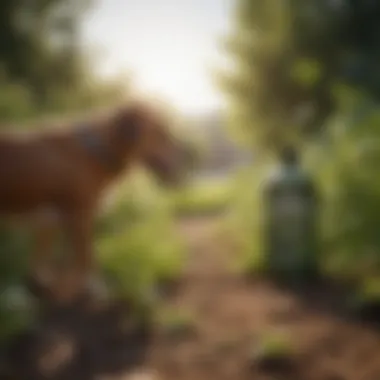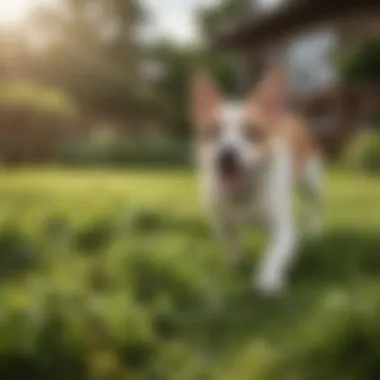Pet Safe Weed Control Solutions for Lush Lawns


Intro
Weeds can be a persistent problem for homeowners aiming to maintain a beautiful lawn. However, for pet owners, the dillema extends beyond aesthetics. The safety of furry companions is essential. Finding effective weed control methods while ensuring the lawn is pet-safe is crucial. This article highlights various pet-safe weed control options, weighing their efficacy and safety.
The casual approach to weed control often incorporates harsh chemicals. Unfortunately, these yard treatments can pose significant health risks to pets who spend time exploring. This concern necessitates a more informed approach. Chemical herbicides are known to have harmful effects on animals if ingested or if they come into contact with treated areas. Understanding alternatives becomes vital for promoting both lawn health and safeguarding pet well-being.
In the following sections, we will explore natural solutions and commercial alternatives within pet-safe weed control. We will delve into recognized best practices for application, and the essential role of active ingredients. By addressing these viewpoints, pet owners can confidently cultivate an inviting lawn without risking their animal companions' health.
Understanding Weed Impact on Lawns and Pets
Weeds are not mere nuisances; they use resources efficiently and compete with desirable plants for sunlight, water, and nutrients. In various conditions, they can thrive unimpeded, straining the overall health of the yard. When conventional chemical methods are applied, these often leave harmful residues that can affect our pets either directly, through ingestion or contact, or indirectly, causing fear and anxiety from unpleasant experiences on treated lawns.
Safeguarding pets while controlling weed growth implies an interaction of strategic choices. Knowledge of which strategies effectively balance these needs is essential. We now turn towards animal-specific considerations related to weed control methods, further tailoring our guidance to those concerned with the safety of their pets. The next section will cover aspects relevant essential that pet owners need to comprehend in the realm of weed management.
Understanding the Importance of Pet Safety
Pest control in lawns is critical not just for the health of the grass, but also for the well-being of pets. These furry companions often spend a lot of time outdoors, exploring and playing. Therefore, ensuring their safety should be a top priority for any pet owner. Understanding the importance of pet safety when managing lawn weeds involves recognizing possible risks, evaluating alternatives, and adhering to best practices.
The Risks of Traditional Weed Control
Many traditional weed control methods utilize chemical herbicides to combat unwanted plants. While effective, these products often contain ingredients that can pose serious health risks to pets. For instance, ingestion or skin contact with chemical weed killers can lead to various symptoms ranging from mild irritation to severe toxicity. Pets are curious creatures, often sniffing or chewing on treated areas, exposing themselves to these hidden dangers.
Additionally, chemical residues can linger in the soil or on the grass for extended periods. This can inadvertently affect pets, even when the application seems finished. Situations exist where pets may come into contact with these chemicals long after treatment, leading to potential health complications. Therefore, it is crucial to be informed about the specific products in your weed control strategy and their potential impact on your pets.
Why Choose Pet-Safe Alternatives
Opting for pet-safe alternatives provides numerous benefits, ensuring that the lawn care is not only effective but also poses minimal risk to beloved animals. Pet-safe options often consist of natural ingredients or specialized blends designed to eliminate weeds without harming pets.
Benefits include:
- Peace of Mind: Knowing that your lawn care practices do not endanger the family pets helps reduce anxiety among pet owners.
- Environmental Safety: Many pet-safe alternatives are less disruptive to local ecosystems, benefiting wildlife and plant life in the surrounding area.
- Healthier soils: Natural weed control techniques often enhance soil health, leading to more robust grass and greener lawns over time.
In summary, opting for alternatives that prioritize pet safety aligns well with responsible pet ownership. The goal is to maintain a pristine lawn without comprising the health and safety of our furry friends. By educating ourselves about various options available, we can operate in a more informed manner. This commitment aids in creating a foothold for better environments for pets while addressing a persistent issue for owners.
Chemical vs.
Natural Weed Control
Weed control is an essential aspect of lawn maintenance, playing a crucial role in maintaining both lawn health and the safety of pets. Choosing between chemical and natural weed control methods invites a broader discussion about effectiveness, environmental impact, and the safety of our animal companions. The considerations involved in this choice are substantial and merit thoughtful examination.
Overview of Chemical Weed Control Products
Chemical weed control products, often referred to as herbicides, make use of potent ingredients designed to target and eradicate unwanted plants. These products can be highly effective and deliver quick results, making them a popular choice among many homeowners. However, their primary disadvantage lies in their toxicity.
Common chemicals in these products include glyphosate and 2,4-D, which can pose threats to neighborhood pets and wildlife if not applied with care. It is crucial to follow dosage recommendations and application guidelines strictly to minimize risks. Always ensure that any product is labeled as pet-safe before proceeding.
Retailers usually have a vast selection of these products, with different concentrations and formulas. Homeowners should research brands carefully, looking for those endorsed or reviewed favorably in pet safety perspectives.
Key Considerations of Chemical Products:
- Potential toxicity to pets and wildlife.
- Restricted application period post-application.
- Adherence to local environmental regulations.


Benefits of Natural Weed Control Methods
Natural weed control methods, on the other hand, present several broad academic as well as ecological advantages. By utilizing organic components, these methods tend to avoid the harsh chemicals synonymous with chemical herbicides.
The lain exeption is they present non-toxic alternatives for dealing with stubborn weeds. Many pet owners find comfort in providing a safer environment for their furry friends. Various natural weed control options can often be created with simple household materials, thus reducing costs associated with more commercially-produced solutions.
Additionally, organic methods typically have a significantly lower environmental impact, contributing less to soil run-off and chemical accumulation in ecosystems. In practice, many pet owners notice that adopting these natural practices supports biodiversity in their garden areas, promoting a broader range of flora and fauna within the lawn space.
Main Advantages of Natural Controls:
- Enhanced safety for pets and wildlife.
- Reduced chances of chemical contamination in soil and water.
- Ingrient accessibility via local supermarkets or already present materials.
Choosing the method for weed control must align with the openly practical needs without compromising the pet ecology.
Homeowners regularly confront choices in their weed management approach, leading to insights about how environment can influence domestic pet safety as well as lawn integrity. Employing an effective blend of strategic ideas may facilitate long-term control and proactive practices achieving healthier lawns without unpleasant side effects. Evaluating the trade-offs of chemical vs. natural weed control is an ongoing journey.
Gathering all necessary information about the subject matter paves the way for knowledgeable decision-making, leading to successful lawn management tailor-fitted to the time-tested love of gardening—safely.
Natural Weed Control Options
Natural weed control methods are essential in achieving a healthy lawn without putting pets at risk. These methods often utilize common household items or natural substances that are not harmful to animals. They can be cost-effective and environmentally friendly, providing benefits that extend beyond just weed removal. Understanding the options available is key to ensuring that the weed control you choose supports both the strength of your lawn and the health and safety of your furry companions.
Vinegar as a Weed Killer
Vinegar stands out as a readily accessible and generally safe weed killer. Its primary component, acetic acid, disrupts the cell processes of plants, leading to wilting and eventual death of the weeds. This is particularly effective for young weeds and those with foliage that can absorb the liquid easily.
When utilizing vinegar for weed control, a few considerations must be taken into account:
- Concentration: Household vinegar typically has a 5% acetic acid concentration, which may be sufficient for small weed infestations. However, for tougher weeds, higher concentrations (up to 20%) are available.
- Application Timing: Targeting weeds on a sunny day can enhance vinegar's effectiveness, as it can dry out the plants quickly.
- Spot Treatment: To minimize exposure to surrounding grass, spot treat weeds directly to avoid harming desired plants.
Ensure to keep pets away during application until the area is completely dry to avoid any potential ingestion. The use of vinegar, while pet-safe, can likewise affect beneficial plants, making it essential to apply carefully and deliberately.
Boiling Water for Effective Elimination
Boiling water can serve as a straightforward and highly effective option for weed removal, especially in garden paths or driveways. When poured directly onto undesirable plants, the heat destroys the cellular structure of weeds, causing immediate wilting and death.
This method offers strong benefits:
- Zero Chemicals: Boiling water uses no chemicals, making it inherently safe for pets and the environment.
- Control: It provides targeted treatment, meaning you can address specific weed patches without impacting surrounding grass.
- Simple and Fast: The process is quick, requiring only a kettle or pot of boiling water that one can pour on the weeds.
Be cautious in approaching boiling water applications around your lawn. If poured directly onto soil, it might also impact any beneficial bacteria and fungi present in the earth, so reserve this technique for areas where vegetation is unwanted.
Corn Gluten Meal: A Preventive Measure
Corn gluten meal is another natural solution that serves as a pet-safe weed preventative. This product can inhibit weed seed germination and effectively manage the growth of new weeds when used properly. It's worth noting that Corn gluten meal is not effective against already existing weeds, serving instead as a preemptive action.
Key points to remember when using corn gluten meal:
- Sprinkling: Apply around established plants before weeds sprout; about 20 pounds per 1000 square feet is recommended for best results.
- Moisture Requirement: For optimum effectiveness, watering after application helps activate the natural compounds found in the gluten meal.
- Pet Safety: Corn gluten is safe for pets, and since it is natural and biodegradable, it contributes to better soil health.
> Ultimately, these natural options provide sustainable weed control solutions while ensuring a safe environment for pets.
Commercial Pet-Safe Weed Control Products


In a world increasingly centered around sustainability and the well-being of pets, commercial pet-safe weed control products form a crucial aspect of lawn care. These products provide efficient solutions to unwanted weeds without posing health risks to pets and other animals. Their significance cannot be understated; they serve as a conscious choice for pet owners who desire attractive lawns while minimizing the potential hazards for their beloved companions.
Identifying Safe Commercial Products
Selecting the right commercial products involves careful research. Look for brands that specifically emphasize safety for pets in their materials. Start by examining certifications that confirm compliance with safety standards, such as the Environmental Protection Agency (EPA) guidelines. Brands like Safer Brand and Green Light have developed a reputation for offering pet-safe alternatives. It helps to read customer reviews and testimonials, as they can provide insights into the product's effectiveness and safety.
Additionally, consider focusing on botanical and organic formulations as a priority in your search. These products typically avoid harmful chemicals yet provide adequate weed-control performance. Users should feel assured when products come with guarantees related to safety and efficacy, making engagement with those brands more reliable.
Understanding Labels and Ingredients
Being able to read and understand labels is fundamental when evaluating weed control products. Manufacturer’s ingredient lists reveal crucial information on the product’s composition. Focus on formulations containing treated proteins, plant-based emulsifiers, and fatty acids, as these tend to be less toxic to pets compared to synthetic herbicides.
Carefully check if there are any warnings or signals focusing on pets or children. The absence of specific hazard language indicates a better-suited product for homes with pets. Phrases like “non-toxic” or “biodegradable” enhance assurance but always validate certifications before such claims can be entirely trusted. To become informed, various online platforms like Wikipedia and Britannica offer valuable tools for understanding gardening practices, ensuring that your decision is effective and well-educated.
As you navigate through the crowded market landscape for pet-safe weed control, it’s essential to balance efficiency and safety. Only by understanding the commercial options effectively can pet owners achieve a harmonious and beautiful lawn that benefits pets and people alike.
Proper choice matters greatly. The health of both your lawn and your pets relies on making informed decisions about weed control products.
Best Practices for Weed Control Application
Effective weed control in a pet-safe environment requires a strategic approach. Employing best practices can significantly enhance both the safety of your pets and the health of your lawn. Understanding the timing, application techniques, and post-application care is crucial to safeguard your furry friends while keeping your grass lush and vibrant.
Timing Your Applications Effectively
Timing weed control applications is vital in determining their success. Applying treatments during the early morning or late afternoon minimizes both heat stress on the lawn and chemical volatility when using commercial solutions. If using a natural method such as vinegar or salt, consider the weather conditions. A clear, dry day is ideal to ensure that the solution remains effective on target plants without being washed away before acting on weeds. Moreover, observing the growth cycles of weeds will allow you to treat them when they are most vulnerable.
- Weed maturity: Young, actively growing weeds are more susceptible to weed control methods.
- Seasonal timing: Target weeds early in their lifecycle to restrict their growth and establishment.
Application Techniques to Minimize Risks
Proper application techniques enhance the efficacy of control methods while reducing the risk to pets. For natural methods, using a pump sprayer or a watering can allows for precision, preventing drift onto desired plants. Keep pets inside during application and for several hours afterward. This precaution will keep them safe while the product works.
Applying products systematically prevents over-application, ensuring a uniform treatment and minimal resources wasted.
- Spot Treatment: Identify and treat specific weed patches instead of applying broadly.
- Avoid areas frequented by pets: Only treat sections of the lawn where pets do not play.
Post-Application Care and Awareness
After applying weed control methods, careful observation is critical. Proper post-application care involves tracking both the health of your lawn and the behaviors of your pets. Monitor how your lawn responds to treatment over the following weeks.
- Keep pets away from treated areas: This is paramount for their safety until you can ascertain full product absorption by the plants.
- Regularly review labels and directions: Understanding the specific waiting times and precautions of the products helps in compliance with recommended safety measures for your beloved pets.
With thoughtful timing and execution, combined with close monitoring post-application, you can help ensure both a healthy lawn and a safe environment for pets. The integration of these practices refines the overall weed management approach while prioritizing the well-being of your animal companions.
Integrating Lawn Maintenance Strategies
The management of your lawn involves several practices that, when properly executed, can significantly reduce weeds. Integrating lawn maintenance strategies is essential, particularly for pet owners. It minimizes the reliance on chemical weed control methods by promoting a healthier and more resilient lawn environment. This holistic approach not only enhances the overall appearance of the lawn but also fosters safety for pets. Incorporating routine maintenance like mowing, watering, and fertilizing effectively can lead to a vibrant, thick turf that suppresses weed growth naturally.
Mowing Practices that Reduce Weeds
Regular mowing is a crucial lawn maintenance step that reduces the potential for weeds to take root. Keeping your grass mowed at an appropriate height can deter weeds from flourishing. Grass that is cut too short can expose the soil, inviting various weed species. Long grass, however, can shade the soil and create an environment unfavorable for weeds to grow. Ideal mowing height generally ranges from two to four inches, depending on the grass type. Furthermore, using sharp mower blades helps prevent grass damage, allowing grass to grow healthy and dense. Therefore, maintain a regular mowing schedule, allowing for consistent upkeep that ultimately manages both your lawn quality and any weed disruptions, thus serving your pet's safety.


Proper Watering Techniques
Watering plays a critical role in the effective management of weed control. How you water can either encourage or discourage both desirable grass and unwanted weeds. Deep and infrequent watering is preferable, as it promotes deeper root growth and helps maintain lawn health. Water early in the morning to avoid evaporation losses. It is important to check soil moisture and adapt watering schedules based on rainfall or drought conditions. Overwatering can create ideal conditions for certain weeds to thrive. Hence, embracing regular observation of your lawn can lead to beneficial adjustments that strengthen desirable grass while combating nearby weed populations.
Fertilization Strategies for Lawn Health
Fertilization is an essential component of lawn maintenance, offering nutrients that boost lawn vigor and competitiveness against weeds. Applying slow-release fertilizers can improve normal grass growth without providing sudden bursts that some weeds exploit. Ideally, fertilizing in the spring and early fall encourages optimal growth at times when grass starts to thrive. You can also focus on organic fertilizers that provide nutrients while maintaining safer conditions for pets. Balanced fertilization enables your lawn to maintain density and texture which acts as a preventative measure against weed activitiy. Routine soil testing can guide you in making precise adjustments in your fertilization practices. By seeing what nutrients your lawn needs, you pave the way for horticultural success against both weeds and maintaining a safe environment for your animals.
Effective lawn maintenance integrates practices that protect your turf from weeds, simultaneously ensuring a safe environment for pets.
Continuously embracing integrated lawn care not only enhances lawn health but sets the stage for effective weed control. This sustainable approach aligns with pet safety, providing long-lasting solutions geared towards a flourishing, weed-free Lawn landscape.
Long-Term Solutions for Weed Prevention
Weed control in lawns is often perceived as a battle against invaders. To truly manage weeds, it’s vital to think long-term. Implementing sustainable management practices not only creates a healthy lawn but also protects your pets. Pet-safe weed control is effective when you adopt strategies that deter weeds over time while preserving the environment for your furry friends.
Understanding long-term solutions emphasizes ecological balance. Choosing a plan that nurtures grass health and soil strength naturally limits weed growth. Further, these methods lead to less need for invasive treatments, reflecting a commitment to pet safety in the lawn care routine.
Benefits of Long-Term Solutions:
- Improved soil health minimizes weed emergence.
- Dense turf can crowd out weed growth.
- Reduced reliance on chemical treatments ensures a safer environment for pets.
- Regenerative practices enhance biodiversity.
Creating a Dense Turf to Prevent Weeds
A dense lawn is your first line of defense against weeds. Strong grass competes against weeds for resources, blocking sunlight and nutrients. To achieve a lush carpet of green, proper mowing, watering, and fertilization are critical. Regular mowing supports a uniform cut, which encourages thick grass growth.
Moreover, selecting a suitable grass type for your climate and soil conditions can make a significant difference. Plants such as Kentucky Bluegrass or tall fescue do well in cooler climates, while Bermudagrass thrives in warmer regions. As well, ensure you:
- Fertilize appropriately during growth seasons for robust development,
- Water regularly, deep, infrequent watering encourages deep root systems,
- Aerate the soil if it becomes compacted, allowing for better nutrient penetration.
By creating a dense turf, you construct a living barrier against unwelcome invaders.
Monitoring and Adaptive Management
Weed prevention demands vigilance. Monitoring your lawn closely helps identify any signs of weed encroachment early on. Different weeds demand different action. This requires a flexible approach.
Adding adaptability to your strategies can tailor your approach as conditions change. Keeping track of the following will assist:
- Seasonal changes in your area's conditions that could shift grass growth or weed activity.
- Individual lawn trends, maintaining a log of weed outbreaks or lawn health fluctuations appears beneficial,
- Adjustments based on your observations can lead to more effective results.
Pet owners must especially remain aware of pets when applying control measures. If introducing new methods, understand how they affect your animals. Amending your strategies based on direct experiences will create a better lawn environment. Adopting this adaptive mindset not only imparts teaching moments for pet care but reinforces a longer-term vision for optimal weed management.
Long-term weed prevention not only safeguards a lawn’s integrity but also aligns with safe practices for beloved pets.
Epilogue
In the realm of effective lawn care, prioritizing the safety of pets while controlling weeds is paramount. This conclusion draws on the previous sections and highlights the importance of pet-safe weed control strategies. Implementing such practices not only enhances the health of your lawn but also ensures a safe environment for pets. Combining natural techniques and safe commercial products, pet owners can cultivate lush spaces devoid of harmful chemicals. It is essential to monitor chosen methods and adapt them as necessary to maintain optimal results.
Recap of Pet-Safe Weed Control Strategies
- Utilizing Natural Solutions: Vinegar, boiling water, and corn gluten meal are all safe options that can effectively eliminate or prevent weeds without harming pets.
- Choosing Commercial Products Wisely: There are a variety of commercially available weed control products labeled as pet-safe. Inspecting labels and understanding their ingredients is crucial.
- Applying Best Practices: Timing applications effectively, using proper techniques, and maintaining a clean post-application environment are key to minimizing risk.
- Integrating Lawn Maintenance: Regular practices like sensible mowing, watering, and fertilization can bolster lawn health, reducing weed emergence.
Encouragement for Safe Lawn Care Practices
Pet safe lawn care is attainable. Emphasizing safe methods not only secures a healthy lawn but also fosters responsibility towards pets and their surroundings. Select natural weed control techniques that mitigate health risks. Hang tags on products to remind others about potential dangers. Seek guidance from professionals knowledgeable in safe gardening. Remember, creating a garden that safeguards animals requires connecting natural practices with knowledge.
Keeping the environment clean, selecting the right tools, and updating devices not just help with weed control but enrich an ecosystem where your pets thrive. Create an ecosystem that encourages not just responsible lawn care, but also harmony between growth and balance.
"Green spaces can flourish when we implement smart strategies that protect both our pets and our planet."







